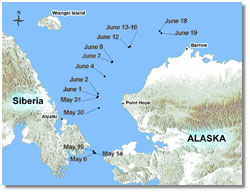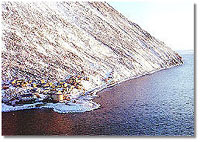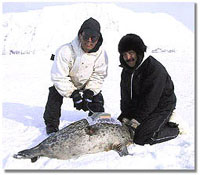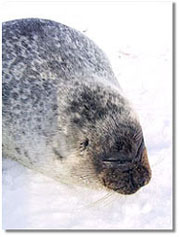|
Using a remarkable combination of time-tested
hunting knowledge, the application of
common-sense ingenuity and high-tech satellite
tracking, researchers supported by the
National Science Foundation (NSF), working
with Alaska Native hunters, have captured,
electronically tagged, and tracked a ringed
seal in its spring migration as it moved
northward with the ice of the Chukchi
Sea.
This is the first time anyone has tracked
a ringed seal in open sea ice, and its
success has not only increased knowledge
about the seal's movements, but also enhanced
trust and mutual respect between scientists
and custodians of traditional ecological
knowledge, according to Gay Sheffield
of the Alaska Department of Fish and Game
(ADFG).
"Seal tracking is an important and somewhat
unexpected offshoot of a larger NSF project
to establish an onshore environmental
observatory on Little Diomede Island in
the Bering Strait and to encourage the
participation of Alaska natives in the
research effort," according to Sheffield,
who oversees marine mammal sampling and
data gathering for the observatory.
Ringed seals are one of the four "ice-associated"
species of seals in those waters. The
others are bearded, ribbon, and spotted
seals.
"In Alaska, the large scale movements of
ringed, bearded, and ribbon seals are
unknown except in a general sense," said
Sheffield. "At this point, the only northern
seals in Alaska for which we have had
even an inkling of their movements are
spotted seals."
The recently tagged seal was captured initially
by island residents using what Sheffield
described as a "clever and effective"
method in which a homemade plywood slide
was deployed from a blind to block the
animal's escape down its breathing hole
in the ice. Scientists then approached
the seal on the ice and temporarily glued
a tracking device to its fur.
Once released, the animal traveled more
than 700 kilometers (400 miles) north
during the period it was tracked -- roughly
seven weeks last summer -- diving to depths
of more than 50 meters (164 feet).
"The great thing is that you have people
sharing information and learning together,"
said Sheffield. "I was working with men
who work with and observe these animals
on a daily basis. They are the experts
on the animal's local behavior and movements.
It was a privilege to be able to unite
scientific and traditional knowledge to
gain a better understanding of ringed
seal life history."
The strategic location of the observatory
on Little Diomede is expected to permit
rapid, flexible collection of chemical,
biological and physical data on the transport
of nutrient- and organic-rich waters of
north Pacific origin into the Arctic Ocean
through the narrow Bering Strait.
Researchers at the University of Alaska,
the University of Maryland and the University
of Tennessee are the principal investigators
for the observatory.
"Little Diomede Island is a challenging,
but rewarding place to work," said Lee
Cooper of the University of Tennessee,
the project lead scientist. "I can't think
of any community in the United States
more remote and isolated, but the support
of the local community has eased a lot
of our research difficulties. We couldn't
have made any significant progress up
there without the community's help."
Note to reporters and editors -
For an image of a ringed seal at 300 dpi,
please contact the media officer named
at the top of this release.
From more information about ringed seals
from the Alaska Department of Fish and
Game see: http://www.state.ak.us/adfg/notebook/marine/rin-seal.htm
|
 |

NSF graphic/Kirk Woellert
A larger
version is here.

Access to Little Diomede is difficult.
Alaska Air National Guard helicopters
provide scientists with transportation.
Photo by Lee Cooper
A larger
version is here.

Little Diomede village.
Photo by Lee Cooper
A larger
version is here.

Two Alaska Native hunters pose with the
tagged seal.
Photo by Gay Sheffield
A larger
version is here.

A ringed seal.
Photo By Lee Cooper
A larger
version is here.
|

